
|
KBR Horse Training Information
Exercising Body AND Mind
|
|
The "Safe Squeeze" Chute
Part Two
|
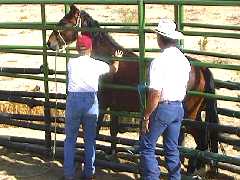
|
|
|
|
HALTERING THE HORSE IN THE SQUEEZE
|
|
|
Once the horse is settled into the squeeze it can be haltered. In this sequence the mare in
the squeeze is rubbed with a lariat prior to being haltered to desensitize her to the feel
of a rope. The objective is to be quiet and make the feel of the rope as comfortable as
possible.
Before the rope is brought in, Mike rubs the horse's head and face looking for unusually sensitive
areas that may need to be worked first.
|
The second handler still maintains a quiet presence behind the horse.
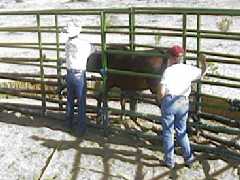
|
|
Next the horse is allowed to investigate the rope. It is a lot safer to both horse and handler
for the horse to be able to figure out that the rope isn't a threat.
Once the horse has checked out the rope she is rubbed by it.
|
The rope is rubbed on the horse until she no longer pops her head up in response.
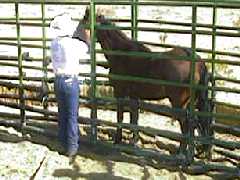
|
|
Next the rope loop is expanded and moved about quietly. The horse needs to get used to the
movement, feel and sound of the rope as it slides through the honda.
If the horse starts to get overly anxious, Mike goes back to the previous "safe spot" and
relaxes the horse by working in comfortable areas while still maintaining contact.
|
The horse will likely respond to the movement of the rope but can learn that it is not threatening.
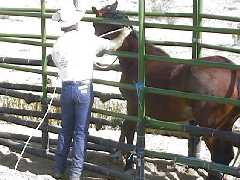
|
|
Once the horse accepts the contact of the rope, the loop can be quietly passed over her head.
The loop should be large enough not to catch her ears, but not so large that it bangs against
the panels. A quiet and steady approach works best.
If the horse has problems with the loop passing past its eyes, additional facial work should
precede a second attempt.
|
Here the horse was properly prepared and is merely looking at the loop around her neck.
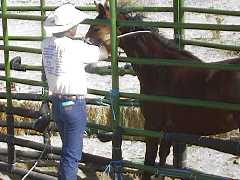
|
|
A portion of the lariat can be formed to make a nose band so that the lariat resembles the look
and feel of a halter.
Once this mare is used to feeling and seeing part of the lariat over the bridge of her nose,
Mike adjusts the back of the loop to make contact similar to a poll strap.
|
She raises her head a little in response to the movement but she never gets excited.
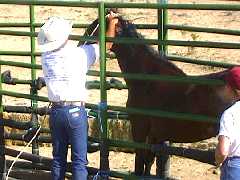
|
|
The actual halter is tied onto the horse while the "lariat halter" is still in place. The purpose
of this is not to restrain the horse with the lariat, but rather maintain the look and feel of the
rope around the nose and poll so that the introduction of the halter is not so different.
|
The mare stays quiet while the halter is applied.

|
|
Once the halter is on, the lariat halter can be undone and quietly removed from the
horse.
Once the horse is settled with all of this, Mike can quietly approach and make any
necessary readjustments to the rope halter.
|
The mare is haltered, not upset, but instead is simply curious.
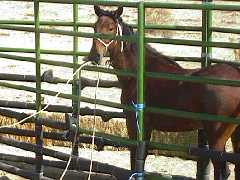
|
|
The end product of a successful squeeze operation is a horse that is haltered,
yet still relaxed. These horses shouldn't be upset about people around them and
they shouldn't be scrambling to get out of the chute once the rear panel is opened.
If the horse has become agitated or is disturbed by the movement of the drag line
attached to it, the handler should wait until it settles down before opening the chute.
The horse should quietly, not fearfully leave the chute as you may want it to go back
into the chute some time in the future without a fight!
|
The mare is staying for a lot of human contact even though the entrance to the chute has been reopened.

|